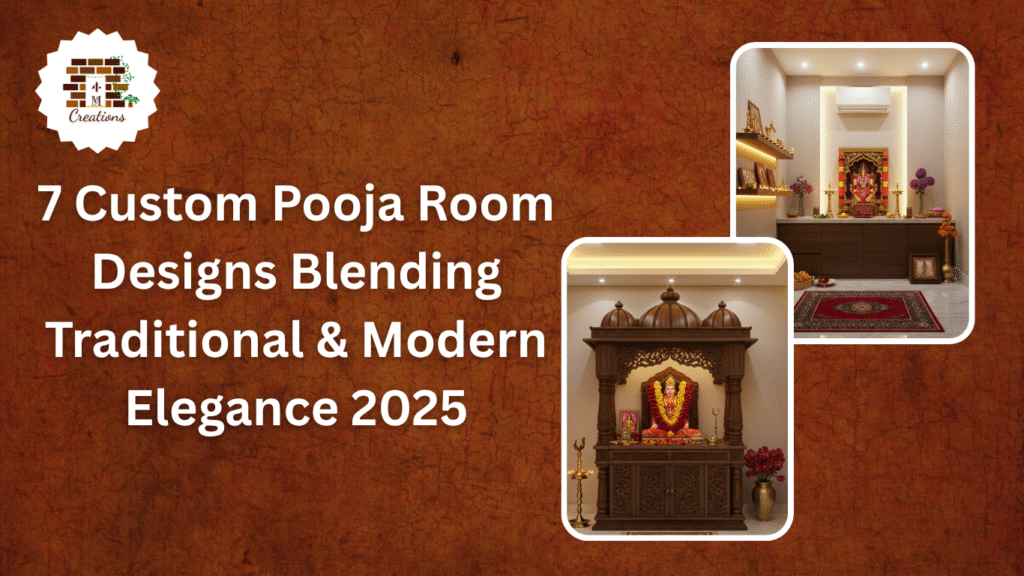7 Custom Pooja Room Designs Blending Traditional & Modern Elegance 2025

In Indian homes, the pooja room is not just a space, it’s a spiritual anchor. A well-designed pooja room brings positive vibrations and harmony into the household. According to Vastu Shastra, placing the mandir in the right direction (ideally the northeast or east) allows divine energy to flow freely, bringing peace and prosperity.
Design is not just about beauty—it’s about energy. The use of natural materials like wood and stone, gentle lighting, and vastu-compliant placement can all enhance the energy in your home, offering not just aesthetic satisfaction, but inner peace.
A timeless favourite, the carved wooden pooja room exudes tradition and grace. Crafted in teak or rosewood, it features detailed temple-style arches, ornamental pillars, and brass bell hangings. A soft, warm backlit marble or granite wall that highlights the idols beautifully. Perfect for spacious villas or heritage homes, this design blends devotion with grandeur, offering a sense of serenity and pride.

This design celebrates purity and peace with pristine white marble as its base. The Jaali (lattice) panels offer both ventilation and intricate beauty, while floral carvings add a spiritual charm. Minimalist brass decor, and elegant wall art give it a modern temple feel. Ideal for duplex homes and independent houses, it brings a light-filled, peaceful aura into your space.

Perfect for modern apartments and compact flats, this sleek wall-mounted unit keeps things simple yet sacred. Crafted in wood or engineered panels, it floats gracefully on the wall, often highlighted by a divine wallpaper backdrop or mantra art. A small drawer can hold pooja items discreetly. It’s minimal in look but mighty in emotion—ideal for those who want devotion on small place.
If you’re a fan of transparent spaces, this pooja room idea blends privacy and elegance. Closed glass panels create a separate sacred zone without breaking the visual flow of your interiors. With wooden or metal framing, soft LED lighting, and modern idols, it’s a perfect fit for open-layout homes and luxury apartments. It feels exclusive yet inviting.

For those who love authenticity, the stone mandapam is a bold and beautiful choice. Constructed with granite or sandstone, it brings the temple vibe home. Accompanied by brass lamps, mango leaf torans, and a traditional kolam design on the floor, this setup feels like a slice of divine heritage. It’s perfect for homes with a South Indian cultural influence or outdoor courtyards in villas.
This pooja room draws its charm from the grandeur of ancient Indian temples. Featuring intricately carved wooden panels, pillared arches, and traditional dome-style ceilings, it evokes a deep spiritual ambience. The use of rich teak or rosewood, combined with brass bells, diyas, and stone or marble flooring, gives the space an authentic, temple-like feel.

A stylish solution for small spaces, this niche is carved into a wall—often in a hallway or living area corner. It’s backlit with an LED panel featuring a lotus, Om symbol, or a Sanskrit shloka. A compact shelf neatly holds the idol and daily pooja essentials. This design is a go-to for city flats or nuclear families who want spiritual presence without taking up much room. It’s simple, soulful, and truly modern.

Common Mistakes to Avoid
- Locating the pooja room near bathrooms or under staircases can disturb the sacred energy and affect the room’s purity.
- Insufficient lighting and poor airflow make the space feel dark and heavy, reducing its peaceful atmosphere.
- Choosing a mandir that’s too large for the space can make the pooja room look crowded and uncomfortable.
- Incorrect placement and facing of idols can disrupt the positive vibrations as per traditional Vastu guidelines.
- Using bright or flashy colours and modern art can take away from the calm, serene environment a pooja room should have.
FAQ's
1. Can I place my pooja room in the living room?
Yes, you can. Use partitions, shelves, or compact wall-mounted units to create a dedicated corner with focus and respect.
2. What is the best direction for a pooja room according to Vastu?
The northeast corner (also called the Ishan kon) is considered the most auspicious direction for a pooja room as per Vastu, inviting peace and positive energy into the home.
3. What materials are best for pooja units?
Wood (especially teak or rosewood), marble, and stone are ideal for traditional durability and elegance.
4. How can I make a modern pooja room look traditional?
Blend modern layouts with traditional elements—like brass decor, diyas, or spiritual motifs
5. Is a separate pooja room necessary in every home?
Not necessary, but even a small, well-decorated corner brings the same spiritual benefits.
Conclusion
No matter the size of your home, there’s always room for devotion. By choosing custom pooja room designs that combine tradition with modern aesthetics, you’re creating not just a sacred corner but a visual delight too.
At 4mcreations, we help you build pooja rooms that don’t just follow Vastu or design trends—they tell your story beautifully. Looking to add a divine touch to your dream home? Let’s talk!
